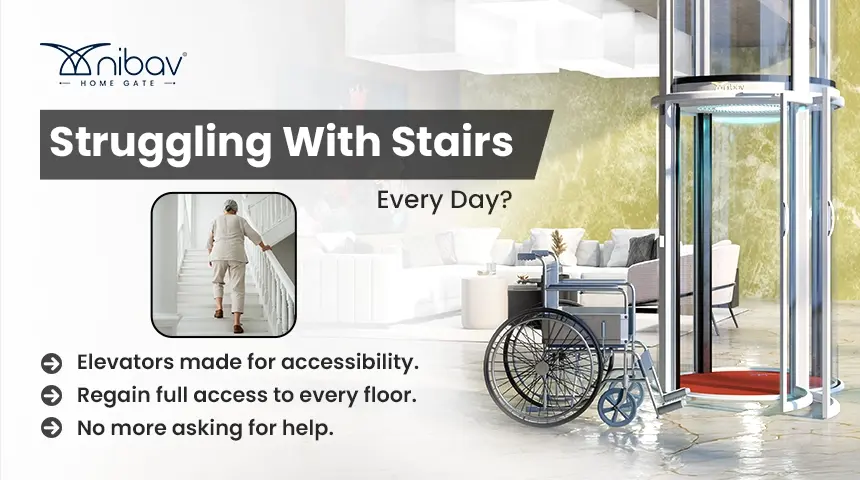Mobility should never be a barrier to independence—especially within the safety and comfort of one’s own home. For handicapped individuals, navigating multi-storey residences can be a daily challenge, often requiring assistance, compromising privacy, and causing unnecessary strain. Fortunately, modern technology now makes it possible to install home lifts for handicapped persons, offering dignity, freedom, and ease like never before.

This blog explores the best home lift solutions tailored for differently-abled individuals, guiding you on how to choose, what to expect, and how to make your space truly inclusive and accessible.
Why Accessibility at Home Is Non-Negotiable
- Safety Comes First
Falls and accidents on stairs are one of the leading causes of injury for those with mobility limitations. A home lift significantly reduces this risk. - Independence Is Empowering
Having the freedom to move independently from one floor to another improves not just accessibility, but also confidence and quality of life. - Family Peace of Mind
Caregivers and family members can relax knowing their loved ones are not struggling or risking injury daily. - Value Addition to Property
Installing a home lift is not just functional; it adds long-term value and futuristic appeal to your property.
What Are Home Lifts for Handicapped Individuals?
Unlike traditional elevators, home lifts for handicapped persons are specifically designed to be compact, safe, and easy to use. These lifts:
- Accommodate wheelchairs or mobility aids
- Include ergonomic control panels
- Come with secure doors and non-slip flooring
- Are installed with minimal structural changes
Types of Home Lifts for Differently-Abled People
1. Hydraulic Home Lifts
- Smooth and quiet operation
- Ideal for 2 to 4 floors
- Emergency power backup
- Customizable interiors
2. Pneumatic Vacuum Lifts
- Air-driven and energy-efficient
- No machine room or pit required
- Transparent design adds aesthetics
- Perfect for villas and modern homes
3. Platform Lifts
- Open design suitable for wheelchair access
- Cost-effective option
- Can be installed both indoors and outdoors
4. Stair Lifts
- Ideal for narrow staircases
- Seat with secure belt
- Remote operation
- Foldable to save space
Key Features to Look for in a Home Lift for Handicapped
- Wheelchair Compatibility
Ensure the cabin size is wide and deep enough to accommodate standard or motorized wheelchairs. - One-Touch Controls
Simplified controls help users operate the lift independently, even with limited hand mobility. - Automatic Doors
Swing or sliding doors that open automatically improve convenience and safety. - Emergency Support
Battery backups, alarms, and phone connections inside the cabin are must-have features. - Low Maintenance Design
Choose lifts that require minimal service and are easy to troubleshoot.
How to Choose the Right Home Lift
Step 1: Evaluate the Space
Not every home has a wide staircase or the structure to accommodate large elevators. Compact vacuum lifts or platform lifts are better suited for space-constrained homes.
Step 2: Understand the User’s Needs
Is the user wheelchair-bound or using a walking aid? Is visual or auditory assistance required? Choose a model that best suits the specific mobility and sensory needs.
Step 3: Check for Certifications
Look for safety certifications like CE, ISO, or ADA-compliance to ensure international quality standards.
Step 4: Future-Proof Your Choice
Consider your long-term needs. It’s wise to choose a solution that can serve for years, even as mobility levels change.
Installation Considerations
- No Civil Work Options Available
Some modern home lifts need no pit or machine room and can be installed within a week. - Low Power Consumption
Choose models that run on single-phase power and consume less energy than traditional elevators. - Customization Options
From colors to glass panels, choose a lift that complements your interior.
Real-Life Benefits for Handicapped Users
- Ramesh, a 68-year-old retired teacher, regained full access to his home after installing a compact air-driven lift.
- Bharathi, a wheelchair user, now moves between three floors independently without help, thanks to an ergonomic platform lift.
These stories are not exceptions—they are becoming the norm with the right accessibility solutions.
Why the Right Brand Matters
Investing in a home lift is not just about buying a product—it’s about trusting a brand that understands inclusive living. Look for providers who offer:
- Post-installation support
- Warranty and AMC
- Certified safety features
- Professional consultation and custom options
Our Recommendation: Nibav Home Lifts
If you’re seeking an ideal solution, Nibav Home Lifts offers high-quality, energy-efficient, and easy-to-install air-driven lifts. They’re designed with special consideration for senior citizens and handicapped individuals. With no major structural changes and a compact footprint, it’s an elegant and effective choice for multi-level accessibility.
Conclusion
Home lifts for handicapped individuals are more than a modern convenience—they are a necessity for safe, inclusive, and empowered living. Whether you’re planning for aging parents, loved ones with disabilities, or just future-proofing your home, installing the right lift can transform your space—and their life.